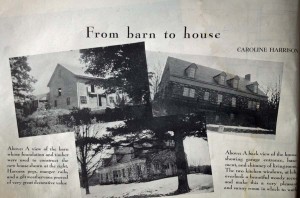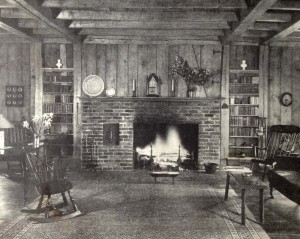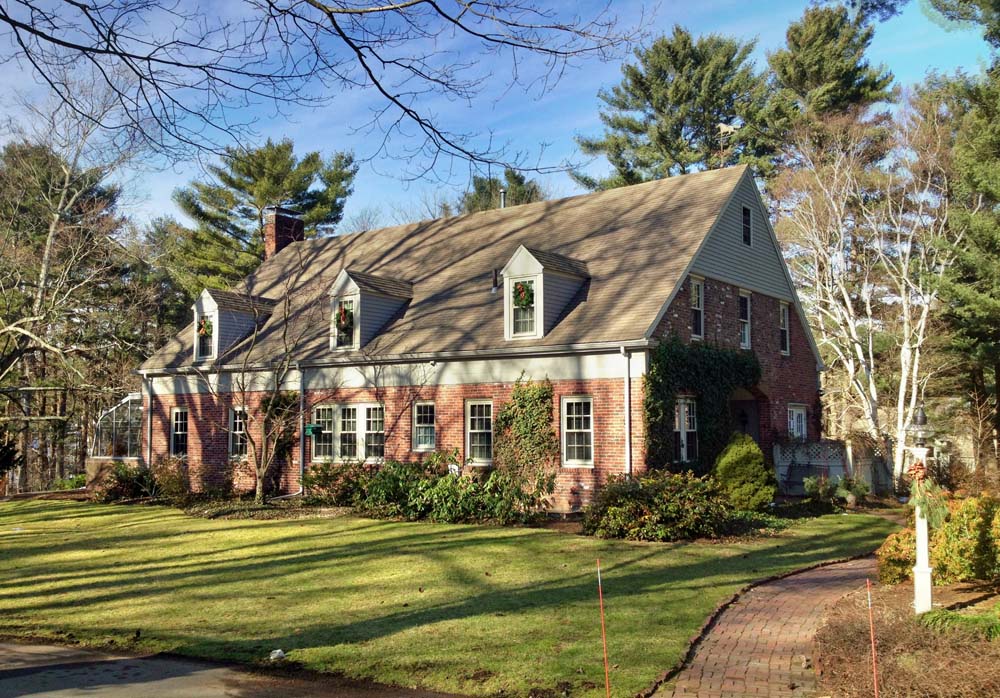True Tales from Canton’s Past: A Place to Call Home
By George T. ComeauAnyone who lives in an old house can tell you that there are stories in every corner of that home. We are simply caretakers of old homes — owning them within a long line of homeowners both in the past and the future.
For a family that really never had their own home, the Harrisons would spend years dreaming of the perfect home. Fosdick Beach Harrison came from a long and prestigious line of Harrisons that dated back to Thomas Harrison, a settler of Branford, Connecticut, from 1645. The men in the family had a history of being in the clergy, and when Fosdick Harrison was born in 1862, he would be destined to follow.
Born in Bethlehem, Connecticut, Harrison attended preparatory school at the Williston Seminary in Easthampton, Mass., and later attended nearby Amherst College. His early life was spent in the pursuit of knowledge. At Amherst, Harrison distinguished himself and excelled in sports and religious studies. Fellow classmates remarked that “he took a vigorous part in the scrimmages.” One story tells of a broken leg caused by a frivolous jump “out of the chapel window.” Completing his educational pursuits at Yale Divinity School, he was ordained a Congregational minister in 1894.
The life of a young minister is built around service, and during Harrison’s life he would move dozens of times. In 1904 he married Estelle Potter of Worcester, and they began to build a family. Potter, the daughter of a wealthy lawyer and prominent politician, was well established in the community. The life that she embarked on with Fosdick would be without any roots or place to truly call home. In fact, their first child (also named Fosdick) was born in Brantford, Ontario, while his father was serving a ministry there.
The family grew, but always in another town in Connecticut or Massachusetts. Places like Palmer, East Bridgewater, Townsend, Somers, Southington, Woodstock, and New Haven were part of a long line of places the Harrisons lived over the years. Finally in 1935, at age 73, completing a stint in nearby Dover, Fosdick Harrison decided to settle down in Canton. Along with his wife and four children, the Harrisons would build an ideal place to call home.
The story goes that Estelle had inherited some money, and with that small purse they could find a site for a dream home. Caroline Harrison, one of the daughters, was a newspaper editor and writer, and she shared the story with American Home Magazine in 1937.

Turning a barn into a home, Caroline Harrison’s story (Courtesy of Liz and George Parker) Click to enlarge
“We felt a tragic insecurity in moving from one parish to another, no home of our own, no improvements we might make lasting,” writes young Caroline. And so in the spring of 1935 they found an old barn at 145 Chapman Street into which they would pour their dreams.
The barn sat in a meadow on the southerly side of the road and was a rambling building that included the small addition of an ell that folklore suggests was the schoolroom that Henry David Thoreau taught in when he was in Canton in 1835-1836. The story is that the Sumner family acquired portions of the old schoolhouse and added the room onto the barn out of nostalgia. Measuring 58 feet by 38 feet, the building had seen better days. Built in 1862, it was equipped with “ample horse stalls, carriage rooms, and a hay loft.”
The barn had something that only the Harrisons could see — a future as their new home. Massive grey oak beams from trees that grew in Canton several hundred years ago made for strong bones. The patina of age was a found object, and the Harrisons began work on July 4, 1935.
Estelle asked her brother for assistance, and Lincoln Potter traveled up from Chevy Chase, Maryland, to supervise the project. Potter had a head for these things and quickly established a plan that called for the complete dismantling of the barn and transforming the parts into a stunning new home. On the existing foundation of the barn, Potter, along with the entire Harrison family, completely dismantled the building and rebuilt it entirely. Serving as architect, contractor, and builder, Potter would recycle the old building to be reborn as a spacious country manse.
Liz and George Parker are fixtures in Canton, but moving here in 1979 from the upper west side of New York City was more than a shock to their system. George had taken a position in Boston with Meredith & Grew, and a family member suggested he look at a house at 203 Chapman Street. The world between New York City and Canton could not have been more foreign, but soon Canton would be their true home.
“We loved that first house, but it abutted seven neighbors,” explained Parker. The names of the abutters flow fast from Parker’s tongue: “Lesieur, Nolan, Coady, Ladow, and Seaman, all connected to our lot — it was a funny little property.” The Parkers decided they might move. In 1991, Liz and George were walking their dog through their neighborhood on Chapman Street and they saw the ghost of the Harrison house.
As Liz explains it, the old Harrison house was “a little creepy.” After the last Harrison moved out, the property — all 14 acres of it — went to a developer who eventually declared bankruptcy, and the abandoned house became owned by Workingman’s Bank. The slate roof had leaks and the house had been quite damaged. The ivy was growing into the house. The Parkers envisioned its greatness. Within months the wreck was theirs, and they began the process of bringing it back to life. Unknowingly, the Parkers had purchased a most amazing home.
In the weeks and months that followed that July 4th in 1936, the first owners, the Harrisons, recycled that old barn and built an amazingly comfortable, modern building that was years ahead of its time. Almost all of the building was recycled. Every harness peg, manger rail, post and beam were all reused in the Harrisons’ first true home. The interior hardware was fashioned from old tools that once hung in the barn. A clevis from a plow and sections of a harrow become hinges and handles. The bricks for the exterior came from an old car barn; every door had been hanging somewhere else in some other home that was demolished but salvaged by the Harrisons.

Photos from American Home Magazine, 1937, featuring an interior view of the Harrison House (Courtesy of Liz and George Parker)
The centerpiece of the house was the hearth. As Caroline writes, “For a family twenty-two years without a hearth fire, this huge fireplace is a constant delight. Uncle Lincoln found in New Hampshire an old chimney from a house built before 1776, and he faced the fireplace with its bricks. He built the fireplace and chimney himself, making a shelf for a coffee pot, and an oven fed from underneath in which roast beef and baked beans have been successfully cooked. The barn’s trap door is the source of the handle on the oven’s lid, and a wagon supplied the hinges on the slanted tobacco cupboard cut in the paneling above the mantel.”
That fireplace is where the Harrisons would gather every New Year’s Eve and build a roaring blaze; the next morning the hot embers would be swept into a small firebox, heating an oven where the First Day stew would be heated. It was a tradition that meant so much to a family that had never had a real home.
There were many joys in the home of the retired minister. Soon after completion, in 1937, the elder Harrison officiated at the marriage of his son, Fosdick, who became a prominent Boston real estate attorney. Moving out of the new house, the young attorney started his family in the adjacent farmhouse that abuts the homestead. Fosdick P. Harrison would later serve Canton as an auxiliary firefighter during World War II.
The clergyman only got to enjoy his home for four years, four months, and 18 days. On February 29, 1940, Reverend Fosdick Harrison died in the house that he loved so much and was buried back in Connecticut. Less than four months later, his grandchild was born with a congenital heart defect and was buried with him in June.
Estelle died four years later in 1945, leaving her children to grow up in the house that they had built. As each child moved on, the lines began to fade and time took its toll. If Liz and George Parker had failed to see the history in the crumbling plaster and the vine-covered bedrooms, it was likely that the story would have ended in a teardown.
Take heart, though, for folks that have a passion for old homes can hear the history and the stories in the walls. Passed to the next generation, the Harrison house is an amazing gift for future homeowners. Liz loves this house; there was that one defining glorious day, when she awoke early and the sun blazed into the living room and the color from the autumn maple leaves cast a brilliant blaze of gold across the oak floors that once were walked upon by Henry David Thoreau himself, and it took her breath away. Now this is a home.
When asked whether she ever thinks of leaving the house, Liz gets a bit misty during her answer: “Sometimes we wonder. Neither of us want to leave this house … as long as we have our health and our faculties, we stay. But in the end, we are just caretakers.” And they have taken good care of the Harrison house.
Short URL: https://www.thecantoncitizen.com/?p=18586











